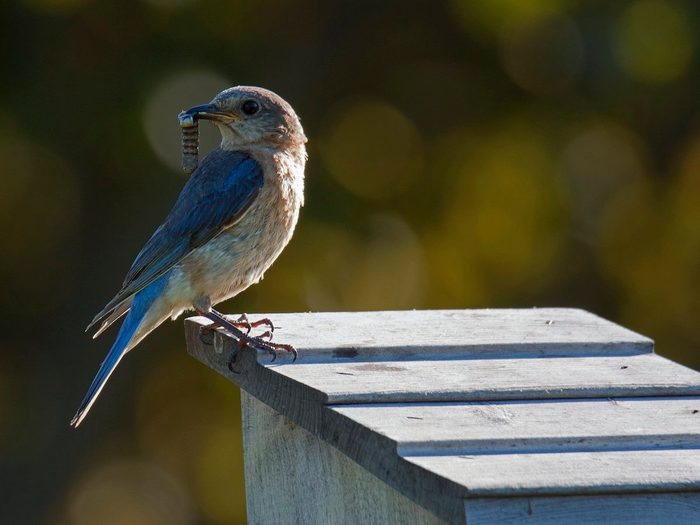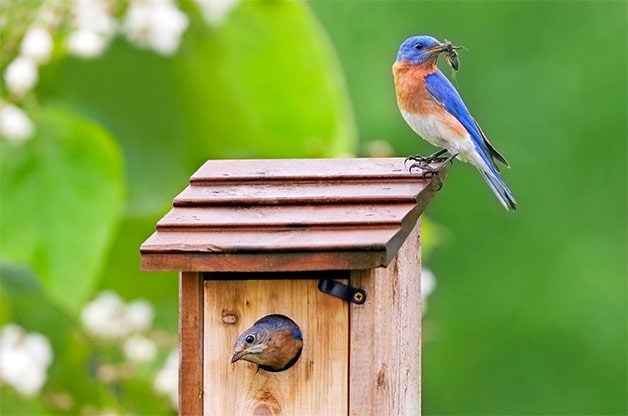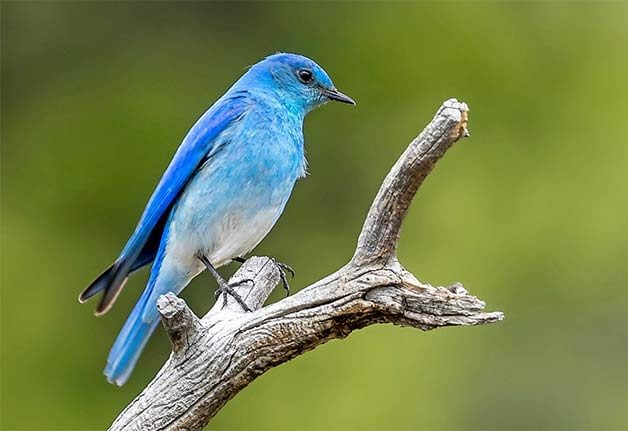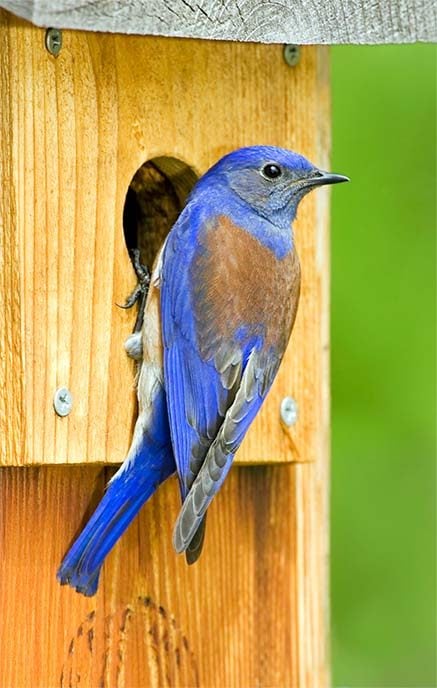Help the Bluebirds: Monitor Bluebird Nest Boxes
Updated: Feb. 22, 2023

Be a bluebird champion! Provide a bluebird box and become a volunteer bluebird monitor to help bluebirds survive and thrive.
Monitoring bluebird nest boxes is one way backyard birders can make a difference. Every time Kathy Kremnitzer lifts the lid of a bluebird box, she says it’s as exciting as opening a present.
“I have the joy of getting an inside look at Mother Nature,” Kathy says. Past president of the Maryland Bluebird Society and longtime secretary of the North American Bluebird Society, she monitors 80 bluebird boxes in her state.
Kathy and other volunteers across the nation get a front-row seat to the life of baby bluebirds, from eggs to fledglings. They help native bluebird species thrive. With some guidance and tools, you can use bluebird boxes and be a bluebird monitor, too.
Here’s how to attract bluebirds.
Bluebird Boxes Help the Birds

Volunteers put up boxes and then keep an eye on them to make sure they’re predator-free throughout the spring breeding season. They also document important information, including the number of eggs and nestlings, and send their findings to the North American Bluebird Society and the Cornell Lab of Ornithology, where researchers study the data.
The movement to save these sky-blue thrushes with their cheery songs began in the 1920s, when habitat changes were causing the birds to lose their natural cavity-nesting sites. They also were getting kicked out of their nests by an increasing population of nonnative birds, such as house sparrows and European starlings. The North American Bluebird Society was formed in 1978. The group shared and promoted information based on decades of research by bluebird fans—where and how to mount the bluebird box, and how to deter predators and nonnative nesters.
Today, monitors in North America belong to many regional, state and national bluebird conservation groups. Thanks to their efforts, the bluebird populations have bounced back.
When volunteers with the Colorado Bluebird Project first began monitoring the birds, fewer than 100 nesting attempts were reported, says Kevin Corwin, Colorado project manager and North American Bluebird Society board member. Now, in a typical year, volunteers in that state report 1,400 to 1,500 attempts (with at least one egg) in nest boxes.
“The key is commitment,” Kevin says. “You have to go out there once a week, check the boxes, document what you see, and if you have an issue like predation, figure out how to solve it.”
Check out the best bluebird feeders and feeding tips.
How to Become a Bluebird Monitor

The best way to begin your bluebird monitor journey is by reaching out to a local, state or national bluebird society. Experts like Kevin can help you get started monitoring a bluebird trail that’s already been set up or can provide information on ways to create your own. You can even put up just one box in your yard as long as you have the right habitat. Semi-open grasslands, like meadows, orchards and mowed lawns, are best. Western bluebirds especially like open lands near ponderosa pines, Kevin says.
Bluebird boxes can be purchased or homemade. Look for boxes and designs approved by the North American Bluebird Society. Fact sheets and plans spell out important details—like the size of the box’s entrance hole. If the entrance hole is larger than 1½ inches, European starlings may get inside.
Learn how to make a DIY bluebird house.
Depending on where you live, bluebirds may raise two or three broods each year. Leave your nest boxes up year-round and clean them out after the nesting season is done.
How to Maintain a Bluebird Box

Once you become a bluebird monitor, you’ll learn to note when eggs are laid and count the days until the young hatch. Don’t worry too much about scaring away the bluebirds when you’re monitoring the boxes. Most of the time, “they’re very tolerant,” Kathy says. You’ll also figure out when the young are almost ready to fledge; then you have to stay away from the box entirely.
Checking to see if other birds are attempting to nest in the boxes is a critical task for monitors. House sparrows are nonnative, so it’s legal to remove their nests. However, leave the nests of tree and violet-green swallows alone—they are native birds and fun to watch, too! Sometimes, placing two bluebird boxes close to one another allows one pair of swallows and one pair of bluebirds to nest side by side.
Monitoring bluebirds is not without challenges and sad times, such as when the eggs don’t hatch. It’s all part of the job. But if you observe the box carefully and do your homework, the chance of negative outcomes should diminish.
“Bluebirds are among the most beautiful animals in the world,” says Kathy. “You have to admire their spirit and determination. There’s just something about them that makes you want to help.”
Next, check out our guide to feeding mealworms to birds.





















